人教版(2019)选择性必修第二册Unit 5 First Aid Reading for writing 课件(共31张PPT)
文档属性
| 名称 | 人教版(2019)选择性必修第二册Unit 5 First Aid Reading for writing 课件(共31张PPT) |  | |
| 格式 | pptx | ||
| 文件大小 | 24.3MB | ||
| 资源类型 | 教案 | ||
| 版本资源 | 人教版(2019) | ||
| 科目 | 英语 | ||
| 更新时间 | 2024-04-14 20:58:50 | ||
图片预览

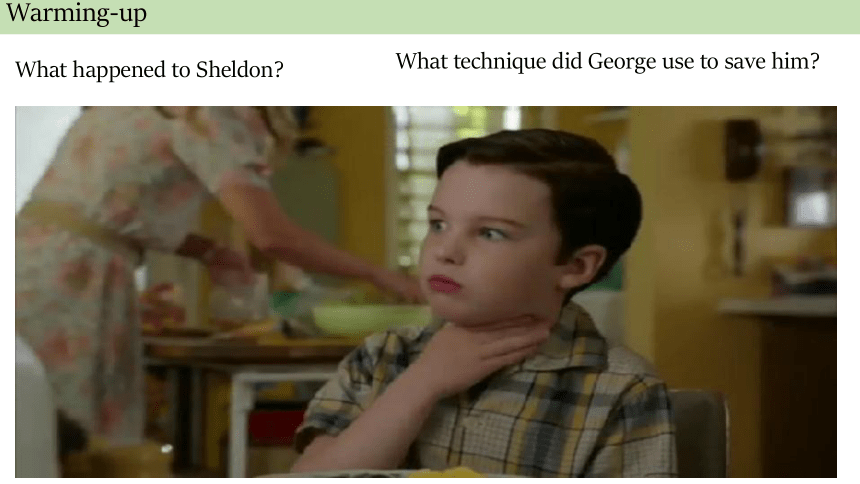
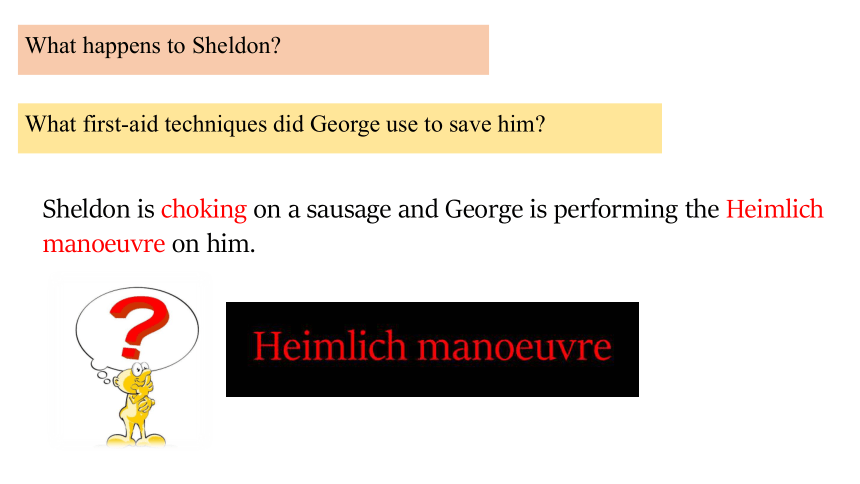
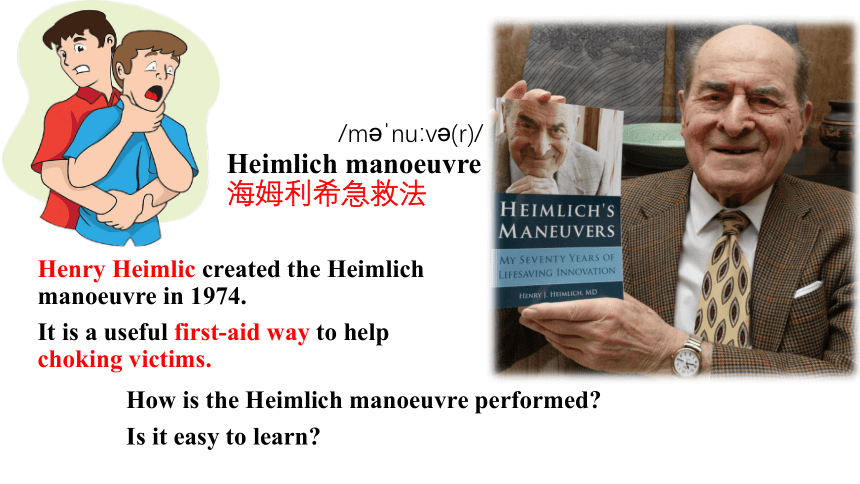
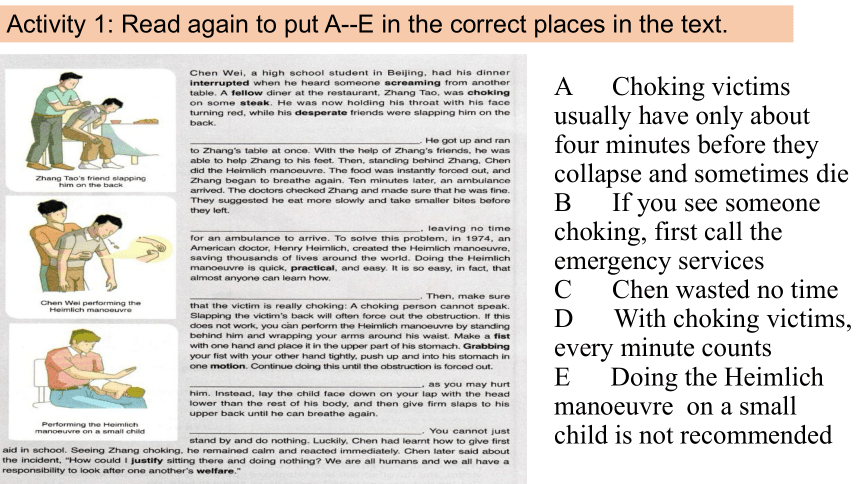
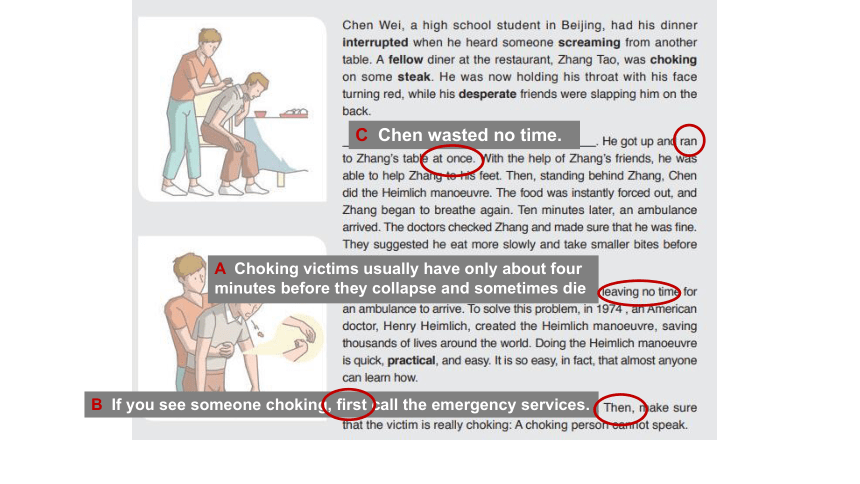
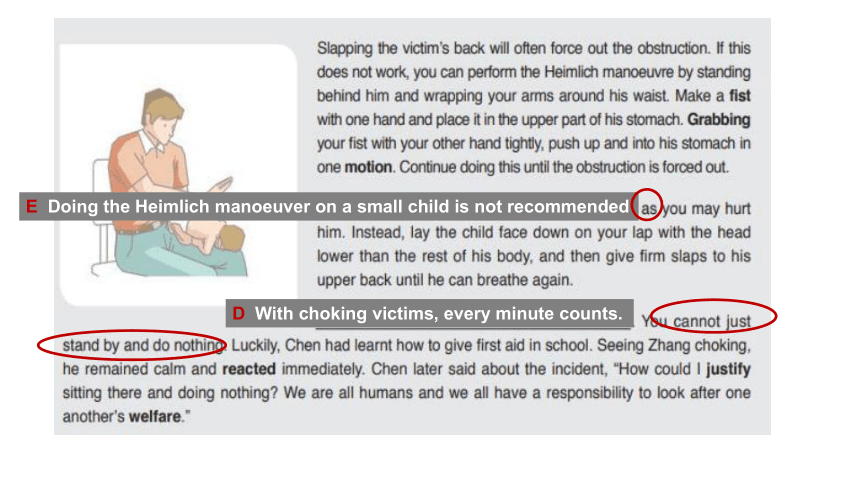
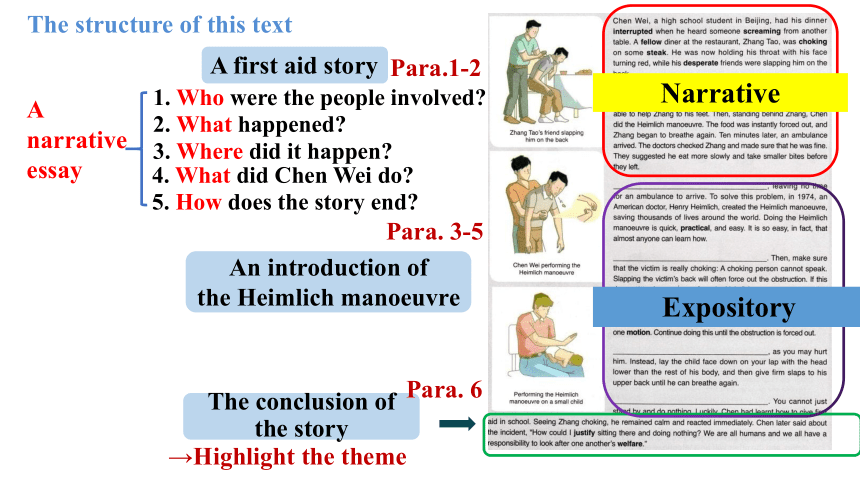


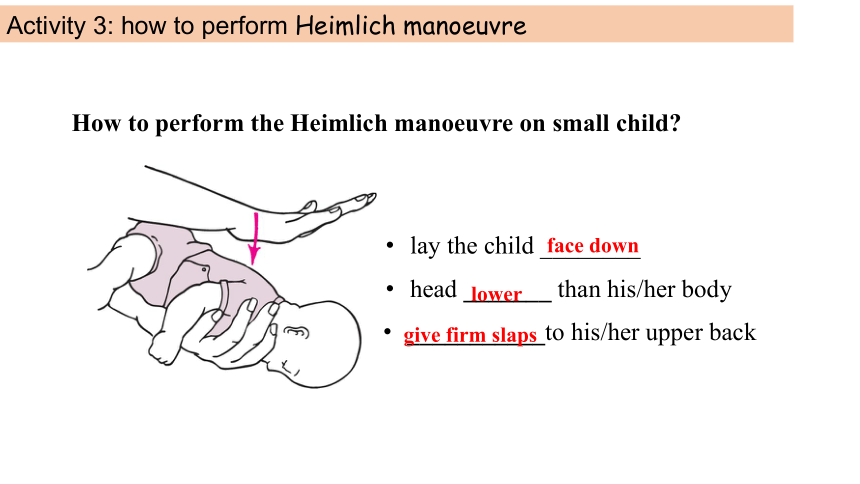

文档简介
(共31张PPT)
Unit 5 First Aid
Reading for writing
Share your story about providing first aid
Warming-up
What happened to Sheldon
What technique did George use to save him
Sheldon is choking on a sausage and George is performing the Heimlich manoeuvre on him.
What happens to Sheldon
What first-aid techniques did George use to save him
Heimlich manoeuvre
海姆利希急救法
Henry Heimlic created the Heimlich manoeuvre in 1974.
It is a useful first-aid way to help choking victims.
/m nu v (r)/
How is the Heimlich manoeuvre performed Is it easy to learn
Activity 1: Read again to put A--E in the correct places in the text.
A Choking victims usually have only about four minutes before they collapse and sometimes die
B If you see someone choking, first call the emergency services
C Chen wasted no time
D With choking victims, every minute counts
E Doing the Heimlich manoeuvre on a small child is not recommended
C Chen wasted no time.
A Choking victims usually have only about four minutes before they collapse and sometimes die
B If you see someone choking, first call the emergency services.
E Doing the Heimlich manoeuver on a small child is not recommended
D With choking victims, every minute counts.
A first aid story
An introduction of
the Heimlich manoeuvre
The conclusion of the story
Para.1-2
Para. 3-5
Para. 6
The structure of this text
→Highlight the theme
1. Who were the people involved
2. What happened
3. Where did it happen
4. What did Chen Wei do
5. How does the story end
A narrative essay
Narrative
Expository
Conclusion: the structure of a narrative essay.
the set-up
who
what
where
the conflict
a challenge or difficulty
the conclusion
the end of the story
Write a narrative essay
A narrative essay tells a story. Like all good stories, it has three parts: the set-up, the conflict, and the conclusion. The set-up tells you about who, what, and where. The conflict always involves a challenge or difficulty that the characters face. The conclusion is the end of the story, where the problem in Part 2 has been solved.
____________him/her
______ your arms around his/her _____
__________with one hand
place it in the ________
of his/her stomach
____________with your other hand tightly
__________and into his/her stomach in one motion
Heimlich manoeuvre for an adult
waist
stand behind
wrap
Activity 3: how to perform Heimlich manoeuvre
make a fist
upper part
grab your fist
push up
lay the child ________
head _______ than his/her body
___________to his/her upper back
How to perform the Heimlich manoeuvre on small child
Activity 3: how to perform Heimlich manoeuvre
face down
lower
give firm slaps
Chen Wei, a high school student in Beijing, had his dinner interrupted when he heard someone screaming from another table. A fellow diner at the restaurant, Zhang Tao, was choking on some steak. He was now holding his throat with his face turning red, while his desperate friends were slapping him on the back.
Read the 1st paragraph and find out the description of the emergency.
action
+
facial expressions/ emotions
Read for Language
Chen wasted no time. He got up and ran to Zhang’s table at once. With the help of Zhang’s friends, he was able to help Zhang to his feet. Then, standing behind Zhang, Chen did the Heimlich manoeuvre.
Read the 2nd paragraph and find out the verbs used to describe Chen’s reaction.
help sb to his/her feet: help sb stand up
What did the underlined verbs show about Chen’s reaction
His help was quick, timely (及时的) and professional.
Read for Language
If you see someone choking, first call the emergency services. Then, make sure that the victim is really choking: A choking person cannot speak. Slapping the victim’s back will often force out the obstruction. If this does not work, you can perform the Heimlich manoeuvre by standing behind him and wrapping your arms around his waist. Make a fist with one hand and place it in the upper part of his stomach. Grabbing your fist with your other hand tightly, push up and into his stomach in one motion. Continue doing this until the obstruction is forced out.
Read the 4th and find out the verbs used to describe how to deal with choking.
Read for Language
Before Heimlich manoeuvre
Call the emergency
Make sure that…
Slap the victim’s back
Performing Heimlich manoeuvre
Stand behind him
Wrap your arms…
Make a fist and place it…
Grab your fist
Push up and into…
Read the 5th paragraph and find out how to perform Heimlich manoeuvre on a small child.
Doing the Heimlich maneuver on a small child is not recommended, as you may hurt him. Instead, lay the child face down on your lap with the head lower than the rest of his body, and then give firm slaps to his upper back until he can breathe again.
precise (精确的) action
+
precise position
Read for Language
Situations Verbs used Others
Emergency
Reaction
How to perform Heimlich manoeuvre
How to perform Heimlich manoeuvre on a small child
Hear sb screaming
Choke on some steak
Hold his throat
His face turning red (facial expressions)
Desperate (emotions)
Got up and ran
Help Zhang to his feet
Stand before
Stand behind
Wrap your arms around his waist
Make a fist and grab your fist
Push up and into his stomach
Continue doing this
Before Heimlich manoeuvre:
Call the emergency
Make sure that…
Slap the victim’s back
Lay the child
Give firm slaps
Position:
Face down on your lap
With head lower than…
To his upper back
Use precise verbs and add other details
Summary1
Read the 1st paragraph and find out how the author linked the sequential (按顺序的) actions or events.
Chen Wei, a high school student in Beijing, had his dinner interrupted when he heard someone screaming from another table. A fellow diner at the restaurant, Zhang Tao, was choking on some steak. He was now holding his throat with his face turning red, while his desperate friends were slapping him on the back.
Read for Language
Read the 2nd paragraph and find out how the author linked the sequential (按顺序的) verbs.
Chen wasted no time. He got up and ran to Zhang’s table at once. With the help of Zhang’s friends, he was able to help Zhang to his feet. Then, standing behind Zhang, Chen did the Heimlich manoeuvre. The food was instantly forced out, and Zhang began to breathe again. Ten minutes later, an ambulance arrived. The doctors checked Zhang and made sure that he was fine. They suggested he eat more slowly and take smaller bites before they left.
Read for Language
Types Examples from the text More examples
Adverbial
Adverbial Clauses
V. ing-form
Now
At once
Then,…
Instantly
Again
Ten minutes later
Immediately,
Before/after that
Soon,…
…
when + instant action
while + continuous action
before + sentence
after + sentence
until + sentence
as soon as + sentence
Use proper ways to link sequential actions
Summary2
hear someone screaming
with his face turning red
standing behind, … did…
Read the last paragraph and think about the meaning of the quote.
Read for Language
How could I justify sitting there and doing nothing
We are all humans and we all have a responsibility to look after one another’s welfare.
It echoes (回应) the previous statement “you cannot just stand by and do nothing” and shows Chen’s kindness and helpfulness.
the general health, happiness and safety
It serves as a call (呼吁) for learning first-aid as a way to help others and ourselves as well.
A proper quote can show the character’s morals (品德), the theme or serves as a strong call for certain action.
The quote in the end depends on your theme.
life-saving
“First-aid is for everyone everywhere.”
“Accidents do happen; make first-aid your best mate.”
first-aid
“You don’t have to be a doctor to save lives.”
“Next to creating a life the finest thing a man can do is to save one.”
-- Abraham Lincoln
“We all have the power to save a life.”
You can choose either a part of the character’s saying or a great man’s as long as your quote helps strengthen your theme.
Extension
How to choose a good quote
Parts Elements Key words
1 Set-up Who Where What happened
2 Development Any conflict(s)
3 Conclusion How does the story end Any comment(s)/ quote(s)
What person/perspective should be used
What verb tense should be used
The first/third person.
Past tense.
A narrative essay on providing first–aid
Writing Assistance
A narrative essay on providing first–aid
Back to the outline
The gist: David发现女儿误吞纽扣,通过急救措施帮助女儿脱险
Parts Elements Key words
1 Set-up Who Where What
2 Development Any conflict(s)
3 Conclusion How does the story end Any comment(s)/ quote(s)
David & his daughter Jane
At home
Jane swallowed a button
Jane choked on a button
frightened, struggling, lips blue
Checked, slapped to her back
David taught first-aid at college
Importance of first-aid:
“When seconds count, an ambulance is often minutes away”.
Drafting your work: structure
One morning, David was working home while watching his infant daughter Jane crawling on the floor. Suddenly, he noticed that she had picked something up and put it in her mouth. Then she began to move like she was struggling. He quickly jumped from his chair and ran over and picked her up. She now had a frightened look on her face with her lips turning blue. However, she was not crying or making a sound.
He carefully opened her mouth to see if there was obstruction. Not finding anything, he then laid her face down on his lap and gave her a few firm slaps to her back. It worked! Within seconds a small button fell from her mouth onto the floor, and she was breathing once again. Thanks to David’s quick thinking, Jane was saved.
David now teaches life-saving techniques at the local college, and he uses this story to impress upon students the need for quick action. “When seconds count,” he said, “an ambulance is often minutes away.”
Part1: the set-up
Part2: the development
Part3: the conclusion
(ending + quote)
Drafting your work: wording
One morning, David was working home while watching his infant daughter Jane crawling on the floor. Suddenly, he noticed that she had picked something up and put it in her mouth. Then she began to move like she was struggling. He quickly jumped from his chair and ran over and picked her up. She now had a frightened look on her face with her lips turning blue. However, she was not crying or making a sound.
He carefully opened her mouth to see if there was obstruction. Not finding anything, he then laid her face down on his lap and gave her a few firm slaps to her back. It worked! Within seconds a small button fell from her mouth onto the floor, and she was breathing once again. Thanks to David’s quick thinking, Jane was saved.
Precise verbs
Detailed description (emotion/ facial expressions/ precise position)
One morning, David was working home while watching his infant daughter Jane crawling on the floor. Suddenly, he noticed that she had picked something up and put it in her mouth. Then she began to move like she was struggling. He quickly jumped from his chair and ran over and picked her up. She now had a frightened look on her face with her lips turning blue. However, she was not crying or making a sound.
He carefully opened her mouth to see if there was obstruction. Not finding anything, he then laid her face down on his lap and gave her a few firm slaps to her back. It worked! Within seconds a small button fell from her mouth onto the floor, and she was breathing once again. Thanks to David’s quick thinking, Jane was saved.
Drafting your work: linking
adverbial
adverbial clause
(while)
David was working home while watching his infant daughter Jane crawling on the floor.
She now had a frightened look on her face with her lips turning blue. However, she was not crying or making a sound.
Not finding anything, he then laid her face down on his lap and gave her a few firm slaps to her back.
Drafting your work: V-ing form
two actions at the same time
two actions at the same time
Ving as the cause
David now teaches life-saving techniques at the local college, and he uses this story to impress upon students the need for quick action. “When seconds count,” he said, “an ambulance is often minutes away.”
Drafting your work: quote
The end of the story
The theme
The quote echoes and restates the theme
Use this checklist to help you revise the draft.
Does your work have three parts
Does the first part tell the readers about who, what, and where
Does the second part show a conflict
Does the third part give the conclusion
Is there a good quote to sum things up
Are the verbs used in your work clear and precise
Are the sequential actions linked in a coherent way
Are the V.ing form used in your work
Unit 5 First Aid
Reading for writing
Share your story about providing first aid
Warming-up
What happened to Sheldon
What technique did George use to save him
Sheldon is choking on a sausage and George is performing the Heimlich manoeuvre on him.
What happens to Sheldon
What first-aid techniques did George use to save him
Heimlich manoeuvre
海姆利希急救法
Henry Heimlic created the Heimlich manoeuvre in 1974.
It is a useful first-aid way to help choking victims.
/m nu v (r)/
How is the Heimlich manoeuvre performed Is it easy to learn
Activity 1: Read again to put A--E in the correct places in the text.
A Choking victims usually have only about four minutes before they collapse and sometimes die
B If you see someone choking, first call the emergency services
C Chen wasted no time
D With choking victims, every minute counts
E Doing the Heimlich manoeuvre on a small child is not recommended
C Chen wasted no time.
A Choking victims usually have only about four minutes before they collapse and sometimes die
B If you see someone choking, first call the emergency services.
E Doing the Heimlich manoeuver on a small child is not recommended
D With choking victims, every minute counts.
A first aid story
An introduction of
the Heimlich manoeuvre
The conclusion of the story
Para.1-2
Para. 3-5
Para. 6
The structure of this text
→Highlight the theme
1. Who were the people involved
2. What happened
3. Where did it happen
4. What did Chen Wei do
5. How does the story end
A narrative essay
Narrative
Expository
Conclusion: the structure of a narrative essay.
the set-up
who
what
where
the conflict
a challenge or difficulty
the conclusion
the end of the story
Write a narrative essay
A narrative essay tells a story. Like all good stories, it has three parts: the set-up, the conflict, and the conclusion. The set-up tells you about who, what, and where. The conflict always involves a challenge or difficulty that the characters face. The conclusion is the end of the story, where the problem in Part 2 has been solved.
____________him/her
______ your arms around his/her _____
__________with one hand
place it in the ________
of his/her stomach
____________with your other hand tightly
__________and into his/her stomach in one motion
Heimlich manoeuvre for an adult
waist
stand behind
wrap
Activity 3: how to perform Heimlich manoeuvre
make a fist
upper part
grab your fist
push up
lay the child ________
head _______ than his/her body
___________to his/her upper back
How to perform the Heimlich manoeuvre on small child
Activity 3: how to perform Heimlich manoeuvre
face down
lower
give firm slaps
Chen Wei, a high school student in Beijing, had his dinner interrupted when he heard someone screaming from another table. A fellow diner at the restaurant, Zhang Tao, was choking on some steak. He was now holding his throat with his face turning red, while his desperate friends were slapping him on the back.
Read the 1st paragraph and find out the description of the emergency.
action
+
facial expressions/ emotions
Read for Language
Chen wasted no time. He got up and ran to Zhang’s table at once. With the help of Zhang’s friends, he was able to help Zhang to his feet. Then, standing behind Zhang, Chen did the Heimlich manoeuvre.
Read the 2nd paragraph and find out the verbs used to describe Chen’s reaction.
help sb to his/her feet: help sb stand up
What did the underlined verbs show about Chen’s reaction
His help was quick, timely (及时的) and professional.
Read for Language
If you see someone choking, first call the emergency services. Then, make sure that the victim is really choking: A choking person cannot speak. Slapping the victim’s back will often force out the obstruction. If this does not work, you can perform the Heimlich manoeuvre by standing behind him and wrapping your arms around his waist. Make a fist with one hand and place it in the upper part of his stomach. Grabbing your fist with your other hand tightly, push up and into his stomach in one motion. Continue doing this until the obstruction is forced out.
Read the 4th and find out the verbs used to describe how to deal with choking.
Read for Language
Before Heimlich manoeuvre
Call the emergency
Make sure that…
Slap the victim’s back
Performing Heimlich manoeuvre
Stand behind him
Wrap your arms…
Make a fist and place it…
Grab your fist
Push up and into…
Read the 5th paragraph and find out how to perform Heimlich manoeuvre on a small child.
Doing the Heimlich maneuver on a small child is not recommended, as you may hurt him. Instead, lay the child face down on your lap with the head lower than the rest of his body, and then give firm slaps to his upper back until he can breathe again.
precise (精确的) action
+
precise position
Read for Language
Situations Verbs used Others
Emergency
Reaction
How to perform Heimlich manoeuvre
How to perform Heimlich manoeuvre on a small child
Hear sb screaming
Choke on some steak
Hold his throat
His face turning red (facial expressions)
Desperate (emotions)
Got up and ran
Help Zhang to his feet
Stand before
Stand behind
Wrap your arms around his waist
Make a fist and grab your fist
Push up and into his stomach
Continue doing this
Before Heimlich manoeuvre:
Call the emergency
Make sure that…
Slap the victim’s back
Lay the child
Give firm slaps
Position:
Face down on your lap
With head lower than…
To his upper back
Use precise verbs and add other details
Summary1
Read the 1st paragraph and find out how the author linked the sequential (按顺序的) actions or events.
Chen Wei, a high school student in Beijing, had his dinner interrupted when he heard someone screaming from another table. A fellow diner at the restaurant, Zhang Tao, was choking on some steak. He was now holding his throat with his face turning red, while his desperate friends were slapping him on the back.
Read for Language
Read the 2nd paragraph and find out how the author linked the sequential (按顺序的) verbs.
Chen wasted no time. He got up and ran to Zhang’s table at once. With the help of Zhang’s friends, he was able to help Zhang to his feet. Then, standing behind Zhang, Chen did the Heimlich manoeuvre. The food was instantly forced out, and Zhang began to breathe again. Ten minutes later, an ambulance arrived. The doctors checked Zhang and made sure that he was fine. They suggested he eat more slowly and take smaller bites before they left.
Read for Language
Types Examples from the text More examples
Adverbial
Adverbial Clauses
V. ing-form
Now
At once
Then,…
Instantly
Again
Ten minutes later
Immediately,
Before/after that
Soon,…
…
when + instant action
while + continuous action
before + sentence
after + sentence
until + sentence
as soon as + sentence
Use proper ways to link sequential actions
Summary2
hear someone screaming
with his face turning red
standing behind, … did…
Read the last paragraph and think about the meaning of the quote.
Read for Language
How could I justify sitting there and doing nothing
We are all humans and we all have a responsibility to look after one another’s welfare.
It echoes (回应) the previous statement “you cannot just stand by and do nothing” and shows Chen’s kindness and helpfulness.
the general health, happiness and safety
It serves as a call (呼吁) for learning first-aid as a way to help others and ourselves as well.
A proper quote can show the character’s morals (品德), the theme or serves as a strong call for certain action.
The quote in the end depends on your theme.
life-saving
“First-aid is for everyone everywhere.”
“Accidents do happen; make first-aid your best mate.”
first-aid
“You don’t have to be a doctor to save lives.”
“Next to creating a life the finest thing a man can do is to save one.”
-- Abraham Lincoln
“We all have the power to save a life.”
You can choose either a part of the character’s saying or a great man’s as long as your quote helps strengthen your theme.
Extension
How to choose a good quote
Parts Elements Key words
1 Set-up Who Where What happened
2 Development Any conflict(s)
3 Conclusion How does the story end Any comment(s)/ quote(s)
What person/perspective should be used
What verb tense should be used
The first/third person.
Past tense.
A narrative essay on providing first–aid
Writing Assistance
A narrative essay on providing first–aid
Back to the outline
The gist: David发现女儿误吞纽扣,通过急救措施帮助女儿脱险
Parts Elements Key words
1 Set-up Who Where What
2 Development Any conflict(s)
3 Conclusion How does the story end Any comment(s)/ quote(s)
David & his daughter Jane
At home
Jane swallowed a button
Jane choked on a button
frightened, struggling, lips blue
Checked, slapped to her back
David taught first-aid at college
Importance of first-aid:
“When seconds count, an ambulance is often minutes away”.
Drafting your work: structure
One morning, David was working home while watching his infant daughter Jane crawling on the floor. Suddenly, he noticed that she had picked something up and put it in her mouth. Then she began to move like she was struggling. He quickly jumped from his chair and ran over and picked her up. She now had a frightened look on her face with her lips turning blue. However, she was not crying or making a sound.
He carefully opened her mouth to see if there was obstruction. Not finding anything, he then laid her face down on his lap and gave her a few firm slaps to her back. It worked! Within seconds a small button fell from her mouth onto the floor, and she was breathing once again. Thanks to David’s quick thinking, Jane was saved.
David now teaches life-saving techniques at the local college, and he uses this story to impress upon students the need for quick action. “When seconds count,” he said, “an ambulance is often minutes away.”
Part1: the set-up
Part2: the development
Part3: the conclusion
(ending + quote)
Drafting your work: wording
One morning, David was working home while watching his infant daughter Jane crawling on the floor. Suddenly, he noticed that she had picked something up and put it in her mouth. Then she began to move like she was struggling. He quickly jumped from his chair and ran over and picked her up. She now had a frightened look on her face with her lips turning blue. However, she was not crying or making a sound.
He carefully opened her mouth to see if there was obstruction. Not finding anything, he then laid her face down on his lap and gave her a few firm slaps to her back. It worked! Within seconds a small button fell from her mouth onto the floor, and she was breathing once again. Thanks to David’s quick thinking, Jane was saved.
Precise verbs
Detailed description (emotion/ facial expressions/ precise position)
One morning, David was working home while watching his infant daughter Jane crawling on the floor. Suddenly, he noticed that she had picked something up and put it in her mouth. Then she began to move like she was struggling. He quickly jumped from his chair and ran over and picked her up. She now had a frightened look on her face with her lips turning blue. However, she was not crying or making a sound.
He carefully opened her mouth to see if there was obstruction. Not finding anything, he then laid her face down on his lap and gave her a few firm slaps to her back. It worked! Within seconds a small button fell from her mouth onto the floor, and she was breathing once again. Thanks to David’s quick thinking, Jane was saved.
Drafting your work: linking
adverbial
adverbial clause
(while)
David was working home while watching his infant daughter Jane crawling on the floor.
She now had a frightened look on her face with her lips turning blue. However, she was not crying or making a sound.
Not finding anything, he then laid her face down on his lap and gave her a few firm slaps to her back.
Drafting your work: V-ing form
two actions at the same time
two actions at the same time
Ving as the cause
David now teaches life-saving techniques at the local college, and he uses this story to impress upon students the need for quick action. “When seconds count,” he said, “an ambulance is often minutes away.”
Drafting your work: quote
The end of the story
The theme
The quote echoes and restates the theme
Use this checklist to help you revise the draft.
Does your work have three parts
Does the first part tell the readers about who, what, and where
Does the second part show a conflict
Does the third part give the conclusion
Is there a good quote to sum things up
Are the verbs used in your work clear and precise
Are the sequential actions linked in a coherent way
Are the V.ing form used in your work
